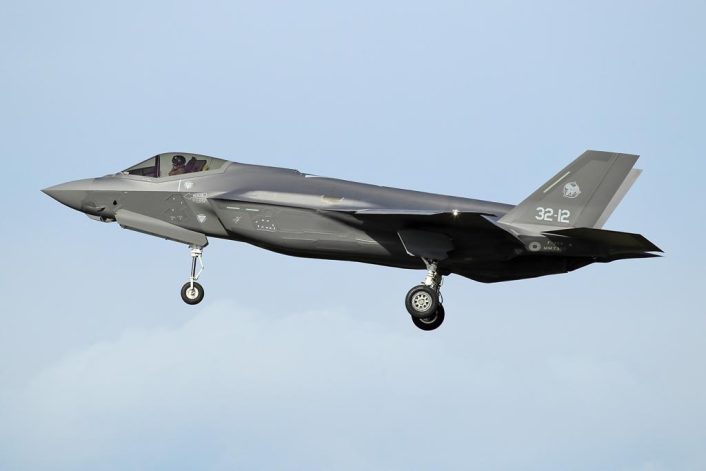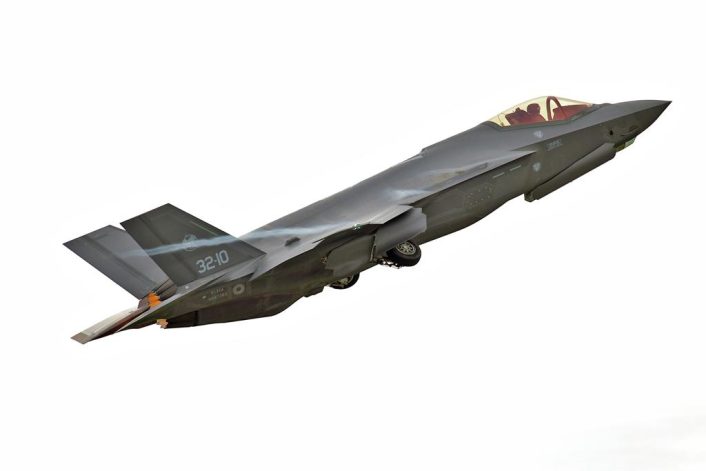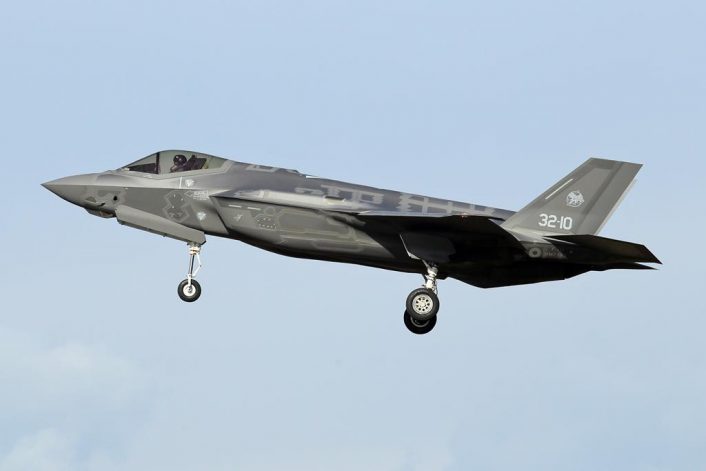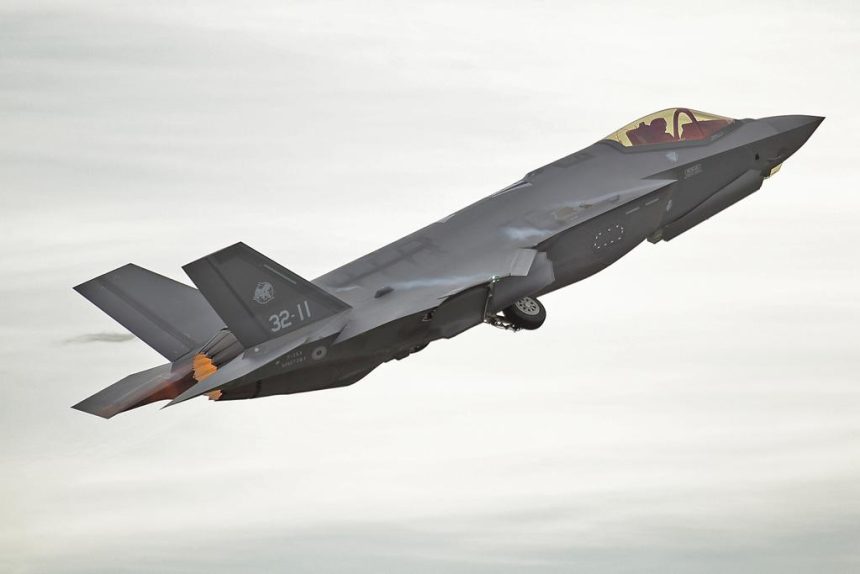During the Exercise, four Italian F-35 Lightning II have carried out missions in the Polygone range and trained with the Italian SIRIUS Surface Based Air Defence (SBAD).
From Oct. 19, four F-35A aircraft, belonging to the 13° Gruppo (Squadron) of the 32° Stormo (Wing), based at Amendola Air Base deployed to Rivolto Air Base, in northeastern Italy, to take part in Exercise Lightning 2020.
As done in June 2018 during the so-called “Operation Lightning”, for two weeks, the 5th generation aircraft have flown several missions from Rivolto (also home of the Italian Air Force Frecce Tricolori display team) to the “Polygone”, located in Germany, near the border with France, to undertake specific training against simulated threats inside the Electronic Warfare range. But the deployment to the base in northeastern Italy provided also an opportunity for the Italian 5th generation pilot to train with the Italian SBAD systems, based in Rivolto and operated by the 2nd Stormo. The latter, is the reference unit for the missile air defense system within the Italian Air Force also responsible of the training and operational readiness of all the personnel in the missile sector of the Italian Air Force.
According to the Italian Air Force, the F-35s carried out multiple simulated SEAD (Suppression Enemy Air Defenses) and DEAD (Destruction Enemy Air Defenses) sorties against the new SIRIUS, that replaced the previous SPADA missile systems, in what the service calls a realistic EW (Electronic Warfare) scenario. Although no additional detail about the mission profiles flown by the Italian stealth jets has been released, the training activity provides an opportunity to recap what’s the current status of the F-35’s capability when it deals with SEAD and DEAD role, that the aircraft will take over in the next decade or so from the Tornado ECR in Italy, and from the F-16 in the U.S.
F-35’s SEAD/DEAD role
It’s not only a matter of syntax, there are substantial differences between a SEAD and a DEAD mission, with the latter aiming at destroying the whole system. For instance, the AGM-88, the type of missile used by the Tornado and Fighting Falcon aircraft, can prevent the employment of a defense system by destroying its radar. The damage on the antenna temporarily denies the use but does not destroy the whole system: if a replacement antenna is available, the whole site becomes operational again in some (usually, short) time. In previous conflicts, the mere presence of assets capable of firing HARM missiles dissuaded the SAM (Surface to Air Missile) sites to turn on their radars. On the other side, a DEAD mission sees the asset use stand-off weapons to destroy the enemy system more or less once and for all.

The F-35 is said to have the ability to locate and track enemy forces, jam radio frequencies and disrupt attacks from stand-off distance. However, it still lacks the integration of a missile for SEAD missions.
While the Block 3F already provided the ability to use, among the other stand-off weapons, also the GBU-39 SDBs (Small Diameter Bombs), at the moment, the AARGM-ER, the missile that will replace the AGM-88 and that the F-35A will be able to carry inside the weapons bay, is at least two or three years away. So, the aircraft’s SEAD capability is mostly reliant on the F-35’s AESA (Active Electronically Scanned Array) radar with sophisticated electronic attack capabilities, including false targets, network attack, advanced jamming and algorithm-packed data streams.
“This system allows the F-35 to reach well-defended targets and suppress enemy radars that threaten the F-35. In addition, the ASQ-239 system provides fully integrated radar warning, targeting support, and self-protection, to detect and defeat surface and airborne threats. While F-35 is capable of stand-off jamming for other aircraft — providing 10 times the effective radiated power of any legacy fighter — F-35s can also operate in closer proximity to the threat (‘stand-in’) to provide jamming power many multiples that of any legacy fighter,” says Lockheed.
Such capability is still somewhat limited, though.
In June this year, the Pentagon awarded Lockheed Martin a $26.7 million contract to improve its SEAD/DEAD capability. The enhancement should be delivered as a retrofit design, applied to both U.S. and foreign F-35s in Lots 14 and 15, and completed by August 2022.

Electronic Warfare ranges
The activity carried out during Exercise Lightning 2020 came immediately after the 13° Gruppo had successfully completed another deployment to Decimomannu Air Base, Sardinia, that marked also the first deployment to the Air Weapons Training Installation (AWTI) for the first Italian Air Force F-35B.
As we reported during the training campaign at the AWTI, local spotters and photographers noticed the aircraft flying at night inside the PISQ (Poligono Interforze Salto di Quirra – Salto di Quirra Joint Range), the EW (range located in central eastern Sardinia, just a few minutes flight time distance from Decimomannu. This is what the former commander of the 155th Gruppo ETS, operating the Tornado ECR in SEAD/DEAD role told us about the differences between the PISQ and Polygone ranges in an interview back in 2017:
“We perform training activities aimed at delivering weapons; air-to-air missions inside the ACMI (Air Combat Maneuvering Installation) range to practice evading aerial threats, and night activity with the NVGs inside the PISQ range. In the latter case, we exploit the light conditions we find inside the EW range, that are far better than those that we can find flying over the Pianura Padana [Plain of the Po] were the light pollution creates visual conditions that are not optimal for the use of night vision goggles. The PISQ is really “dark” and this helps up preparing night SEAD scenarios perfectly tailored to our needs. The basic training for all the aircrews that are assigned to the squadron (and until they achieve the Combat Readiness status) as well as pilots and NAVs who need to keep their currencies, takes place at the Polygone. This range offers a lot in terms of available threats, including real and simulated air defense systems, and provides an immediate feedback on the effectiveness of the used tactics. Although complete, the type of scenarios the Polygone offers is quite basic, in terms of complexity, so we carry out the most advanced part of our training during multinational exercises (such as those in Israel or the Red Flag in the US), especially those drills that have a particular focus on EW. That said, we deploy to Deci for that niche training (night SEAD with NVGs) that would be difficult to arrange and perform abroad. Besides flying in the EW ranges we carry out joint training missions with the Italian Army and Navy as well as the Air Force’s own Spada anti-aircraft systems.”










